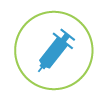Safe and Affordable Treatments for Rabies

Globally, more than 3.3 billion people live at risk of exposure to canine rabies and nearly 200 people die from rabies every day.1

Rabies is 100% curable with appropriate treatment but nearly 100% lethal without timely treatment.

We are developing effective, inexpensive treatments against rabies to promote global access and support rabies control efforts.
Despite rabies' status as well-controlled in the United States and Europe, the deadly disease continues to place an undue public health and economic burden on many developing countries. Globally, more than 3.3 billion people live at risk of exposure to rabies and of this number, nearly half are concentrated in the Southeast Asian region.1 It is estimated that nearly 200 people die from rabies every day, though due to under-reporting by rural and low-income areas, the true burden of the disease remains largely unknown.
The rabies virus is transmitted to humans by animal bites and scratches. Victims initially experience fever, pain, and burning at the site of the wound and within a couple of hours, the highly infectious virus causes a progressive inflammation of the brain and spinal cord. Once clinical signs develop, rabies is almost invariably fatal.2
Rabies disproportionately affects rural communities and the poor and often claims the lives of those without access to safe and affordable treatment. For the poor who live on less than $1 per day, a single treatment regimen at US$250 per treatment is prohibitively expensive. Additionally, rural towns or villages are often times out of the reach of cold-chain suppliers which is necessary for vaccine transport.
It is our goal to reduce the burden of rabies in developing countries and set the stage for sustainable, long-term global prevention. In this project, we are tackling two factors critical to controlling rabies - widespread accessibility and universal affordability of treatments - using a highly integrated approach that combines techno-economic and business innovation.
Current Project (Pilot Stage): Bangladesh
Bangladesh is one of the epicenters of the rabies epidemic in Southeast Asia. We have partnered with organizations like Bangladesh Anti-Rabies Alliance (BARA) and the Government of Bangladesh and aim to equip the country with the knowledge and technology to transition from one of the largest importers of these treatments to an independent producer.
Our activities will include:
- Conducting epidemiological studies to establish incidence of rabies.
- Completing safety and efficacy trials.
- Transfering technology to relevant enterprises, governments, and partners.
- Helping design appropriate production process development and regulatory approval process.

